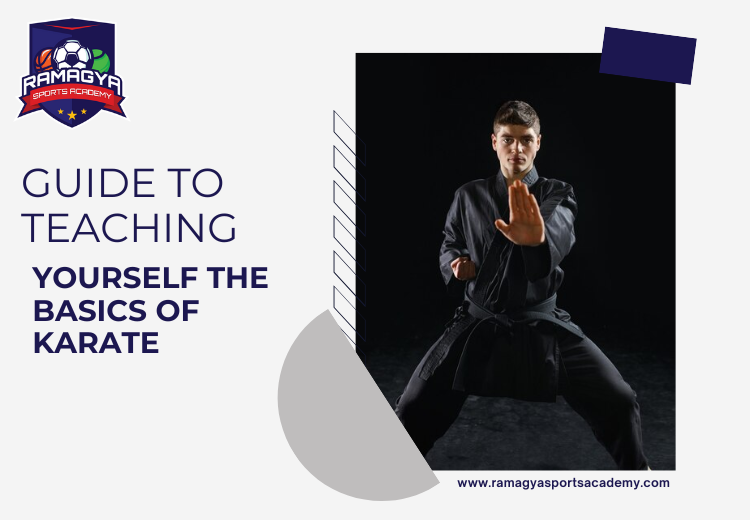
Step into the world of chess brilliance at the Global Sports Academy Chess Festival!
June 10, 2024
Joy of Dance: Why You Should Consider Taking Dance Lessons
June 12, 2024Guide to Teaching Yourself the Basics of Karate
 Beyond only martial arts, karate is more. It is also a discipline that develops self-assurance, physical strength, and mental focus. Learn the fundamentals of Karate, and you can challenge yourself to focus on self-awareness, self-preservation, or wellness. Even while taking classes with a teacher is ideal for beginners, you may still teach yourself the fundamentals by being patient and dedicated. This blog will lead you through the fundamental strategies, pre-training methods, and mindset required to begin your Karate journey alone. It is essential to learn the Basics of Karate.
Beyond only martial arts, karate is more. It is also a discipline that develops self-assurance, physical strength, and mental focus. Learn the fundamentals of Karate, and you can challenge yourself to focus on self-awareness, self-preservation, or wellness. Even while taking classes with a teacher is ideal for beginners, you may still teach yourself the fundamentals by being patient and dedicated. This blog will lead you through the fundamental strategies, pre-training methods, and mindset required to begin your Karate journey alone. It is essential to learn the Basics of Karate.
What will we all go through in this blog?
- Grasping Karate: Karate is a traditional martial art from Japan that originated in Okinawa. It is characterized by the use of elbow and knee strikes in addition to punches and kicks. In addition, there is a focus on power, speed, and accuracy in the process execution. Karate experts, also known as karateka, follow a structured curriculum that includes combat (kumite), katas (structures), and fundamental techniques. You can advance in Karate by becoming an expert in the fundamental techniques.
- Putting forth Objectives: Prior to jumping into preparing, finalizing your goals is fundamental. Would you like to learn Karate as a type of self-protection? Is it safe to say that you are keen on health, competition, or self-awareness? You will remain inspired and precise assuming you set clear, achievable objectives. Divide your objectives into short and long term goals. For example, following a particular method, further developing adaptability or moving up to the belt positions are instances of momentary objectives. Your objectives ought to be reasonable and ready to adjust to your own advancement and preferences.
- Creating a Training Space: You should find a space that is suitable for practicing Karate safely and comfortably. This space should be large enough for you to move freely around without any obstacles. Remove any furniture or other objects that may pose a danger during training. To reduce the chance of injury, consider investing in a Karate Mat or using a non slippery surface. To enhance your training, ensure that you have adequate lighting and ventilation.
- Basic Techniques: Become familiar with the essentials of positions like the normal position (shizen-tai), the front position, (zenkutsu dachi), or the horse riding position, (kiba dachi). Karate procedures are based on positions, which give strength, balance and power.
- Punches: Practice fundamental punches like the straight punch (chokuzuki), uppercut punch (agezuki), and hook punch (kagizuki). Center around the proper arrangement, extension and withdrawal, as well as creating power with the hips.
- Kicks: Become familiar with the key kicks like front kick (mae geri), roundhouse (mawashi geri) and sidekick (yoko geri). Keep your balance and focus on the extension, withdrawal, and chambering of the leg.
- Blocks – Learn the essential blocking techniques such as the inward (uchi) and outward (soto) block, as well as the downward. Practice the correct positioning of your arms and hands in order to effectively deflect incoming attacks.
- Training Methods:
-
- Solo Practice: Set aside time for solo sessions to improve your technique, build muscle memory, and improve coordination. Mirrors and video recordings can be used to check your technique and form.
- Shadow Boxing Drills: Include shadow boxing drills in your training to simulate sparring situations and improve your fluidity. Visualize imaginary opponents, and practice punches and kicks with speed and accuracy.
- Kata Practice: Learn and practice Karate Kata, which is a predetermined sequence of movements that simulates combat scenarios. Kata training improves coordination, balance, and concentration, while also teaching the principles of distance, timing, and rhythm. Strength training, flexibility exercises and cardiovascular workouts can be added to your Karate training. To improve your physical fitness, focus on functional strength, agility and endurance.
- Mindset & Discipline: Karate is more than just physical techniques. It’s about developing the right mentality and discipline. Your training should be approached with humility, dedication and perseverance. Accept challenges as an opportunity for learning and growth. Even when the progress is slow or difficult, remain patient and persistent. To prevent injury, respect your body’s limitations and don’t push yourself past your limits. To improve your performance, cultivate self-awareness and mindfulness.
- Requesting Feedback and Guidance: You can learn the basics of Karate by yourself, but seeking feedback and guidance from instructors or experienced practitioners will enhance your learning. To gain valuable insight, corrections and tips to improve, attend seminars, workshops or online courses taught by qualified instructors. Join local Karate communities or clubs to interact with other enthusiasts, share knowledge and receive mentorship. Open yourself up to constructive criticism, which can help you improve your technique and identify improvement areas.



